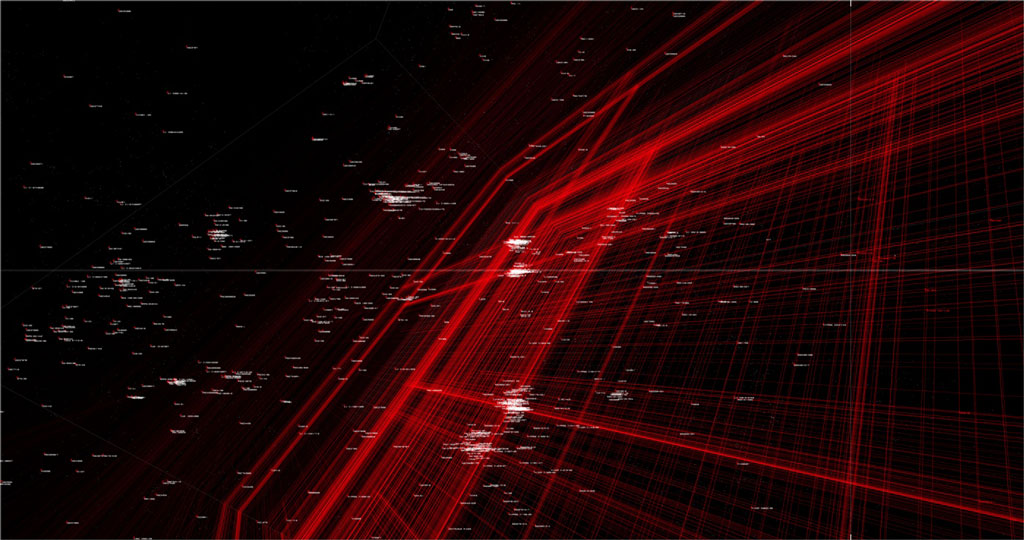ART-PRESENTATION: Ryoji Ikeda, data-verse
 One of Japan’s leading visual artists and composers, Ryoji Ikeda is celebrated for his immersive audiovisual installations and performances that use projections to visualise the translation of data into sound and vice versa. Ikeda’s works frequently materialise as audiovisual installations or performances where visitors are invited to step inside and play among shadows and pulsating patterns, losing themselves in the hypnotic environments.
One of Japan’s leading visual artists and composers, Ryoji Ikeda is celebrated for his immersive audiovisual installations and performances that use projections to visualise the translation of data into sound and vice versa. Ikeda’s works frequently materialise as audiovisual installations or performances where visitors are invited to step inside and play among shadows and pulsating patterns, losing themselves in the hypnotic environments.
By Efi Michalarou
Photo: Kunstmuseum Wolfsburg Archive
Ryoji Ikeda’s works reflect the progressive digitalization of our society and allow viewers to visually and acoustically experience digital universes. With the exhibition “Data-Verse” the Kunstmuseum Wolfsburg is presenting, for the first time together, two new large-scale projections, which are installed site-specifically in the Museum space: “data-verse 1” and “data-verse 2”. With his works, Ryoji Ikeda strives to “capture the world down to the smallest detail”. His light and sound installations have their origins in mathematics, physics, and biology, as well as in musicology and philosophy. Ikeda succeeds in making the abstract volumes of data and computing power we deal with every day comprehensible. He lets viewers immerse themselves in digital universes, which oscillate between the smallest measurable units, i.e. bits and bytes, and cosmic dimensions, they give the impression as if, with the data streams, one were on a journey through space. On the one hand, the surrounding architecture is decisive for his installations and is taken into account in the set-up of the works. On the other hand, visitors to the exhibition are invited to move about in the space in order to reevaluate their own perception and sound out the relationship between space and time. The pulsating sounds underlying the installations range in their spectrum from barely audible sine tones to dull, physically perceptible bass sounds. The latest 4K projection technology contributes to transforming the exhibition into a fascinating total synesthetic experience. Ryoji Ikeda‘s introduction to contemporary art and sonic media began in the early 1990s, when he worked as an audiovisual producer at Spiral Gallery in Tokyo. In 1993, he became a member of the production team for Kyoto-based artist collective Dumb Type, where he focused on working with sound. Between 1996 and 2002, Ikeda released four records with the experimental label Touch—”+/-“ (1996), “0ºC” (1998), “Matrix” (2000) and “op.” (2002), in which he challenges the threshold of the perception of noise through layering glitch, minimal, ambient and string sounds. Ikeda’s early works hint at the artist’s ongoing fascination with the relationship between music and mathematics, particularly binary numbers and data. In 2005, through the German avantgarde label Raster-Noton, Ikeda released “Dataplex”, an album of 20 minimalist, electronica recordings. Encompassing intermittent buzzes, high-pitched beeps, pulsing noises and instrumental sounds, the album culminated by the end of the record as an immersive soundscape. For his 2008 “Test Pattern” work, the artist designed a system that converts data (including that from text, sounds, photos or movies) into flickering black-and-white barcode patterns that are then projected onto a screen and synchronised to music. “Supercodex” (2013) operates on a similar system, for which Ikeda incorporated quantum calculations to translate audio information into video projections. At its first iteration in Tokyo in 2013, the screen was divided into two vertical sections, over which pulsated DNA-like helixes, pixelated patterns, striated lines and descending clouds. Similarly, commissioned by the Park Avenue Armory, New York, in 2011, Ikeda created an immersive audiovisual installation titled “the transfinite”. The work consisted of a darkened room lit by images projected onto an enormous wall and floor. On one side of the room, projections featured horizontal monochrome lines and bands that constantly flickered and alternated in tandem with the soundtrack. On the other side of the installation, the metadata of the installation—such as the programming behind the binary codes for video projections—were presented as numbers and diagrams projected on the wall and the floor. In addition to installations, Ikeda also works in two dimensions with a focus on materialising the imperceptible. In “Time and Space”, an ongoing series since 2010, Ikeda utilises filmstrips as a medium to represent time. “4’33″” (2014), for instance, is an artwork comprised of 16mm magnetic film strips used for movie soundtracks, and pays tribute to John Cage’s work by the same name. Another series titled “Systematics” (2012– ) archives the evolution of the various applications of data by encasing piano rolls for player pianos or punched cards for vintage computers (in acrylic panels. Presented as lightboxes, these artworks highlight attempts to communicate information through data that operates unseen. Ikeda’s interest in mathematics and atomic science has also led him to interdisciplinary collaborations. “V≠L” (2008– ), a series of multimedia works that explore the mathematical concept of “axiom of constructability” is a result of the artist’s discussions with Harvard number theorist Benedict Gross. In 2014 Ikeda was awarded the artist-in-residency programme at CERN, Geneva, where he worked with a scientist to study particle physics.
Info: Curator: Andreas Beitin, Kunstmuseum Wolfsburg, Hollerplatz 1, Wolfsburg, Duration: 7/12/19-29/3/20, Days & Hours: Tue-sun 11:00-18:00, www.kunstmuseum-wolfsburg.de





